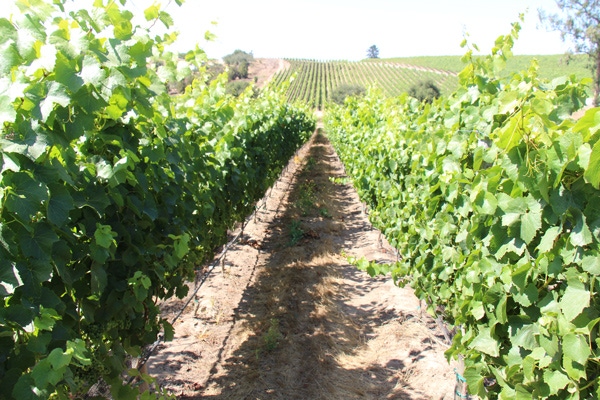
San Joaquin County growers learn lessons in managing water and dry soils
Verdegaal points out, it has long been recognized that water deficits can actually improve fruit quality, especially in red wine varieties, by reducing vegetative growth and improving accumulation of sugars and other compounds related to color and flavor. At the same time, slight deficits can limit excessive growth of shoots and leaves that can affect diseases, such as bunch rot.

Following three straight years of scant rainfall and restricted allocations of surface water, San Joaquin County wine grape growers are learning how to deal with dry soil conditions.
They’re taking advantage of the precision application capabilities of their drip irrigation systems to fine-tune their regulated deficit irrigation (RDI) practices, reports Paul Verdegaal, the county’s University of California Cooperative Extension viticulture farm advisor. By restricting the amount of water used by their vines to less than what a fully-watered vine would use, growers here are conserving water while minimizing any reduction in yields or stress on the crop.
As Verdegaal points out, it has long been recognized that water deficits can actually improve fruit quality, especially in red wine varieties, by reducing vegetative growth and improving accumulation of sugars and other compounds related to color and flavor. At the same time, slight deficits can limit excessive growth of shoots and leaves that can affect diseases, such as bunch rot.
The growers are learning another lesson as well. “RDI and nutrient management go hand-in-hand,” Verdegaal says. “Both will help growers in developing their plans for water and nutrient use required by new regulations aimed at protecting groundwater quality.”
Despite California’s ongoing drought, ground water levels in San Joaquin County don’t appear to be dropping as dramatically as reported in the southern end of the San Joaquin Valley. Some growers have deepened wells to reach water. Others are lowering them just in case the added depth is needed in the future, Verdegaal notes.
Several factors may be limiting any drop in the water table here, he adds. The proximity of the land to the Sacramento Delta, rivers running across both the north and south ends of the county and welcomed rains in late February and early March. “The storms were perfectly timed for the vines and produced a good amount of rain,” Verdegaal says.
Nevertheless, San Joaquin County’s wine grape growers started this year with very dry soils. Typically, growers do not irrigate their dormant vineyards. This year, he reports, some growers irrigated as much as three times during the winter to replace rains that failed to arrive.
This year, the county’s wine grape crop appears to be down from the big crops of the last two years to about average or slightly below depending on variety and soil type, Verdegaal notes.
“As the soils dried out during the season, the clusters and berries may not have developed to their full potential,” he says. “So far the crop doesn’t seem all that much lighter than average. Most growers who have been using RDI for the past several years have seen very good quality of fruit and little to no difference in yields from years past.”
As the harvest began, a number of growers were reporting the appearance of summer bunch rot in their vineyards, he adds. It’s caused by a wide range of fungi which invade the ripening fruit where the skin was injured by insect or bird feeding, mechanical damage or growth cracks, depending on seasonal conditions. There are some indications that lesions from powdery mildew or black measles can make berry skins more susceptible.
Verdegaal suggests a combination of events – perhaps the late winter rainfall, dry weather requiring more irrigation this year and several hot and cold spells during the season—as possibly contributing to development of the rot this year. “These factors may have weakened the skins and created a tight enough cluster architecture that left vulnerable varieties, like Zinfandel and Petite Syrah among others, more susceptible to the rot,” he says.
In his newsletter at the beginning of this year, Verdegaal cautioned growers that dry soils could impair functioning of the vine roots, limiting uptake of such nutrients as boron, potassium and nitrogen and contributing to erratic budbreak.
As it turned out, the vines most affected this way were very old Zinfandel vines and young vines less than four years old, especially where the grapes received little or no water during the winter, he says.
About the Author(s)
You May Also Like



